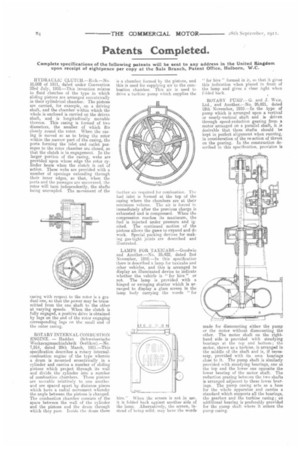Patents Completed.
Page 22

If you've noticed an error in this article please click here to report it so we can fix it.
Complete specifications of the following !patents will be sent to any address in the United Kingdom upon receipt of eightpence per copy at the Sale Branch, Patent Office, Holborn, W.C.
HYDRAULIC CLUTCH.—Rich.—No. 10,008 of 1911, daied under Convention 23rd July, 1910.—This invention relates to fluid clutches of the type in which sliding pistons are arranged eccentrically in their cylindrical chamber. The pistons are carried, for example, on a 'driving shaft, and the chamber within which the whole is enclosed is carried on the driven shaft, and is longitudinally movable thereon. This casing is formed of two diameters, the smaller of which fits closely round the rotor. When the casing is moved so as to bring the rotor within the narrow part of the casing, the ports forming the inlet and outlet passages to the rotor chamber are closed, so that the clutch is in engagement. In the larger portion of the casing, webs are provided upon whose edge the rotor cylinder bears when the clutch is out of action, These webs are provided with a number of openings extending through their inner edges, so that, when the ports and the passages are uncovered, The rotor will turn independently, the shafts being uncoupled. The movement of the
casing with respect to the rotor is a gradual one, so that the power may be transmitted from the one shaft to the other at varying speeds. When the clutch is fully engaged, a positive drive is obtained by )ugs on the end of the rotor engaging corresponding lugs on the small end of the outer casing.
ROTARY INTERNAL-COMBUSTION ENGINE. — Haddam (Schweizerische Werkzeugmaschinfabrik Oerlikon).—No. 7,914, dated 29th March, 1911.—This specification describes a rotary internalcombustion engine of the type wherein a drum is mounted eccentrically in a cylinder and carries a number of sliding pistons which project through its wall and divide the cylinder into a number of combustion chambers. These pistons are movable relatively to one anothei and are spaced apart by distanoe pieces which have a radial movement whereby the angle between the pistons is changed. The combustion chamber consists of the space between the wall of the cylinder and the pistons and the drum through which they pass. Inside the drum there
is a chamber formed by the pistons, and this is used for supplying air to the combustion chamber. This air is used to drive a turbine pump which supplies the
further air required for combustion. The fuel inlet is formed at the top of the casing where the chambers are at their minimum volume. The air is forced in immediately after the previous charge is exhausted and is compressed. When the compression reaches its maximum, the fuel is injected under pressure and ignited. The continued motion of the pistons allows the gases to expand and do work. Special packing devices for making gas-tight joints are described and illustrated.
LAMPS FOR TAXICABS.—Goodwin and Another.—No. 25,422, dated 2nd November, 1910.—In this specification there is described a lamp for taxicabs and other vehicles, and this is arranged to display an illuminated device to indicate whether the vehicle is " for hire " or not. The lamp is provided with a hinged or swinging shutter which is arranged to display a glass screen in the lamp body carrying the words " for hire." When the screen is not in use, it is folded back against another side of the lamp. Alternatively, the screen, instead of being solid. may, have the words
" for hire " formed in it, so that it gives this indication when placed in front of the lamp and gives a clear light when f'dded hack.
ROTARY PUMP.—G. and J. Weir, Ltd., and Another.—No. 26,821, dated 18th November, 1910.—In the type of pump which is arranged upon a vertical or nearly-vertical shaft and is driven through speed-reduction gearing from a motor arranged on a parallel shaft, it is desirable that these shafts should be kept in perfect alignment when running, in consideration of the re-action of thrust On the gearing. In the construction described in this specification, provision is made for dismounting either the pump or the motor without dismounting the other. The motor shaft on the righthand side is provided with steadying bearings at the top and bottom; the motor, shown as a turbine, is arranged in the middle of the shaft and is, if necessary, provided with its own bearings close to it. The pump shaft is similarly provided with steadying hearings, one at the top and the lower one opposite the lower hearing of the motor shaft. The reduction gearing between the two shafts is arranged adjacent to these lower bearings. The pump casing acts as a base for the whole apparatus and carries a standard which supports all the bearings, the gearbox and the turbine casing; an additional bearing is preferably provided for the pump shaft where it enters the pump casing.






















